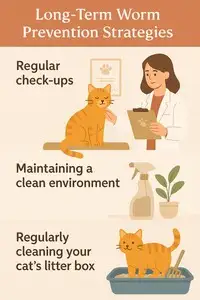Identifying Worms in Cats: A Step-by-Step Guide
How to Detect and Diagnose Worm Infestations in Cats?
Worm infestations are a common health issue in cats, with a significant percentage of the feline population affected worldwide. In fact, it’s estimated that nearly a quarter of cats will be infected with worms at some point in their lives.
Detecting worms in cats is crucial for their health and wellbeing. Regular diagnosis can help prevent complications and ensure your pet receives timely treatment. Feline worm diagnosis involves a series of simple steps that can be performed at home or with the assistance of a veterinarian.
Understanding how to identify worms in your cat is the first step towards effective treatment and prevention. This guide will walk you through the process, providing you with the knowledge you need to keep your cat healthy.
Understanding the Threat of Worms in Cats
Recognizing and Managing Worm Infestations in Cats
Worms in cats can cause a variety of health problems, from mild discomfort to life-threatening conditions. The presence of these parasites can lead to a range of symptoms that affect a cat’s overall health and well-being.
Common signs of worm infestation include weight loss, digestive issues, and lethargy. If left untreated, worm infestations can lead to more severe health complications, such as anemia, intestinal blockages, and even organ damage.
Recognizing the signs of worms in cats is crucial for prompt treatment and preventing long-term damage. Cat owners should be vigilant about monitoring their pets for any unusual behavior or symptoms that could indicate a worm infestation.
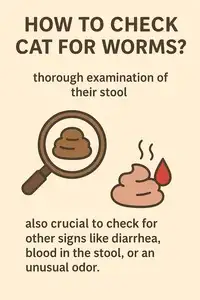
Common Types of Worms That Infect Cats
Understanding the different types of worms that infect cats is essential for effective treatment and prevention of feline parasite detection.
Cats are susceptible to various parasitic infections, with the most common types being roundworms, hookworms, tapeworms, and whipworms.
- Roundworms: These are the most common intestinal parasites found in cats. They are typically transmitted through the mother’s milk or by ingesting infected feces.
- Hookworms: Hookworms are blood-feeding parasites that can cause anemia in cats. They are usually contracted through skin contact with contaminated soil. These worms have an appearance of a hook, so they are named after the hooks. These worms have hook-like teeth they use to attach themselves to the lining of your cat’s intestinal walls. These parasites extract blood and other nutrients and, causing diarrhea and anemia.
- Tapeworms: Tapeworms are segmented parasites that can infect cats through the ingestion of infected fleas or contaminated meat. Tapeworms in cats are flat in appearance and can vary in size from less than an inch to two and a half yards.
- Whipworms: Whipworms are less common in cats but can still cause significant health issues. They are typically ingested through contaminated soil or feces.
- Roundworms in cats are thin, pretty long, and disgusting to look at. These intestinal parasites resemble a piece of spaghetti and are the most common type of worms found in most pets.
Worms in cat feces are often a visible sign of infection, making regular fecal examinations crucial for diagnosis.
Recognizing the types of worms that infect cats is the first step in managing and treating parasitic infections effectively.
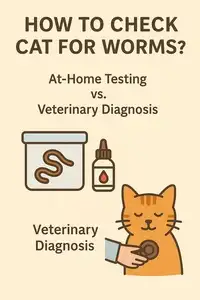
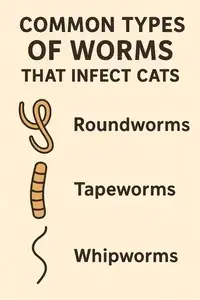
Recognizing Symptoms of Worm Infestation in Cats
Recognizing the signs of worm infestation in cats is crucial for their health and wellbeing. Cats infected with worms may exhibit a variety of symptoms that can range from mild to severe.
One of the common symptoms of worm infestation is a change in appetite. Some cats may experience an increase in appetite, while others may lose their appetite altogether. Weight loss is another significant indicator, often accompanied by a general decline in the cat’s overall health.
Gastrointestinal issues are also prevalent among cats with worm infestations. Symptoms can include diarrhea, vomiting, or constipation. In severe cases, worms can cause intestinal blockages, which can be life-threatening.
- Visible worms or worm segments in the cat’s stool or around the anus
- A pot-bellied appearance, particularly in kittens
- Dull coat or skin problems
- Lethargy or lack of energy
If you suspect your cat has a worm infestation, it’s essential to consult with a veterinarian for a proper diagnosis and treatment plan. Early detection and treatment are critical in managing worm infestations and preventing long-term health issues in cats.

How Cats Get Infected by Worms ?
Understanding how cats get infected by worms is crucial for preventing parasite infestations. Cats can become infected through various routes.
Cats can ingest worm eggs or larvae through contaminated food, water, or soil. For instance, if a cat eats prey that is infected, such as a mouse carrying tapeworm larvae, it can become infected.
Contact with infected animals is another common way cats get worms. This can happen during fights or when they share food or litter boxes with an infected cat.
To reduce the risk of infection, cat owners should ensure their pets have a clean environment, avoid eating raw or undercooked meat, and prevent them from hunting rodents.
Regular veterinary check-ups are also essential for early detection and treatment of worm infestations.
By understanding these risks and taking preventive measures, cat owners can significantly reduce the likelihood of their cat becoming infected with worms.
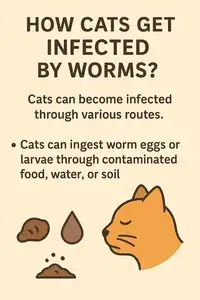
How To Check Cat For Worms? A Detailed Examination
To ensure your cat’s health, it’s essential to know how to check for worms. Regular checks can help identify signs of worm infestation early on.
How do you know if your cat is having worms!!
By knowing their signs you will be able to take precautionary measures for the future. In this blog, we will try to show all the variants of worms that your kittens might face and how to check cats for worms. Once you pick which type of worm, you are dealing with, you can get your cat treated right away.
Worms in cats are, like enemies to your cat’s health. They are intestinal parasites and can be found living in the digestive tract of your cat’s body.
They can link themselves with the lining of the intestine and parts of it and can extract all the vital nutrition. Once you buy a cat, you have to be sure of its health.
Checking your cat for worms involves a thorough examination of their stool. Fresh stool samples are ideal for detecting worms or their eggs.
What to Look For in Fresh Stool
When examining your cat’s stool, look for visible signs of worms, such as small, white or brown specks or segments that resemble rice grains.
It’s also crucial to check for other signs like diarrhea, blood in the stool, or an unusual odor.
A magnifying glass can be a useful tool in detecting worms or their eggs in your cat’s stool.
By magnifying the sample, you can more easily identify any abnormalities that may indicate a worm infestation.
Regularly checking your cat for worms and being aware of the signs can help prevent serious health issues.
Symptoms of Worm Infestation to Your Cat’s Body
According to our profession, the sigs may vary according to the capability of the body antibodies, but they can include:
- Diarrhea (containing worms and worms segments)
- vomiting
- Dehydration and loss of appetite
- Anemia and pale gums
- Abdominal enlargement
- Weight loss
- Lethargy
- Constipation
- Black-tarry stools
- Rough-looking coat
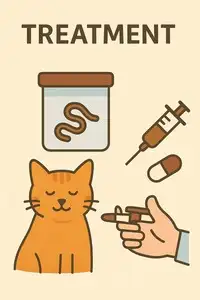
At-Home Testing vs. Veterinary Diagnosis
Diagnosis
If your cat is not treated at the right amount of time, the infestation of the worms will continue until the immunity is compromised.
And in cases of a low immune system, the body becomes prone to other diseases and loses the chance to fight off, ultimately resulting in the decline of your cat’s health.
Diagnosing the issue related to your kitty requires examination of a fresh stool sample. With the help of some lab machines, the sample is tested, and the concerned parasite is found.
ners often face a dilemma: whether to opt for at-home testing or seek a veterinary diagnosis.
At-home testing kits are available over-the-counter or online, allowing cat owners to collect a stool sample and send it to a laboratory for analysis. While this method can be convenient, it may not always be accurate.
Veterinary diagnosis, on the other hand, involves a more comprehensive examination, including a physical check-up, medical history, and laboratory tests. This approach provides a more accurate diagnosis and is often recommended for severe or persistent infestations.
Here are some key differences between at-home testing and veterinary diagnosis:
- Accuracy: Veterinary diagnosis is generally more accurate than at-home testing.
- Comprehensive Care: A veterinarian can provide guidance on treatment and prevention, in addition to diagnosis.
- Severity Assessment: Veterinary diagnosis can assess the severity of the infestation and potential complications.
In conclusion, while at-home testing can be a useful initial step, a veterinary diagnosis is often the best course of action for accurately identifying and treating worm infestations in cats.
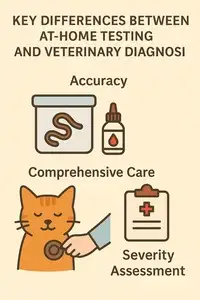
Treatment Options for Cat Worm Infestations
The treatment of worm infestations in cats involves a combination of medications and lifestyle changes. Effective treatment is crucial to prevent re-infestation and ensure the cat’s overall health.
Medications are the primary treatment for worm infestations in cats. Various anthelmintic medications are available, including deworming tablets, topical treatments, and injections. The type of medication used depends on the type of worm infestation and the severity of the infection. For example, medications containing praziquantel are effective against tapeworms, while those containing fenbendazole are effective against hookworms and roundworms.
In addition to medications, lifestyle changes can help prevent re-infestation. Keeping the cat’s living area clean, disposing of feces regularly, and preventing the cat from hunting rodents can reduce the risk of worm infestations. Regular grooming and inspecting the cat’s feces for signs of worms can also help identify infestations early.
Some cat owners may also consider natural or holistic approaches to treating worm infestations, such as dietary changes or herbal remedies. However, it is essential to consult with a veterinarian before attempting any alternative treatments to ensure they are safe and effective.
By combining medications with lifestyle changes and regular monitoring, cat owners can effectively treat worm infestations and prevent re-infestation, ensuring their cat’s overall health and well-being.
Treatment
After an appropriate diagnosis and the type of worm are identified, a type of dwarfing medicine will be given to act against the worms inside the intestine.
Multiple infestations at the same time have been seen in many cases inside a cat’s body, so a proper diagnosis is essential for ridding your pet of these parasites.
If you have multiple cats, there are chances of all the cats getting infected at the same or different times, based on their reaction to the body, especially if they are sharing the same litter box. We hope you got the idea on how to check cats for worms
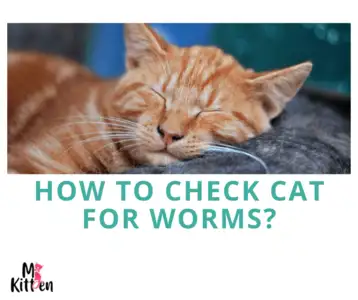
Protecting Your Cat's Health: Long-Term Worm Prevention Strategies
To keep your cat healthy, it’s essential to implement long-term strategies for preventing worm infestations. Regular check-ups with a veterinarian play a crucial role in feline parasite detection and early treatment.
Maintaining a clean environment is also vital. Regularly cleaning your cat’s litter box and disposing of cat feces properly can help reduce the risk of worms in cat feces. This simple practice can significantly impact detecting worms in cats.
Using preventative medications as prescribed by your veterinarian is another effective way to protect your cat. These medications can help prevent worm infestations and reduce the risk of transmission.
By combining regular veterinary check-ups, a clean environment, and preventative medications, you can significantly reduce the risk of worm infestations in your cat. This proactive approach will help ensure your cat’s overall health and well-being.
How Cats Get Infected by the Worms?
- Playing in the same soil with the worms
- Ingesting the plants in the soil contaminated with the parasite.
- Open with the excreta of an infected animal.
- Ingesting fleas with the parasite
- Nursing by a mother contaminated with the worm.
- Eating contaminated prey such as mice and birds
Prevention
- Do not allow your cat to play in the mud and soil.
- Keep out the stray cats of your cat’s reach.
- Maintain the grooming by our professionals.
Make sure you get a routine checkup of your kitty to bring a difference in the quality of life from the start. We hope now you got the idea on how to check cats for worms
